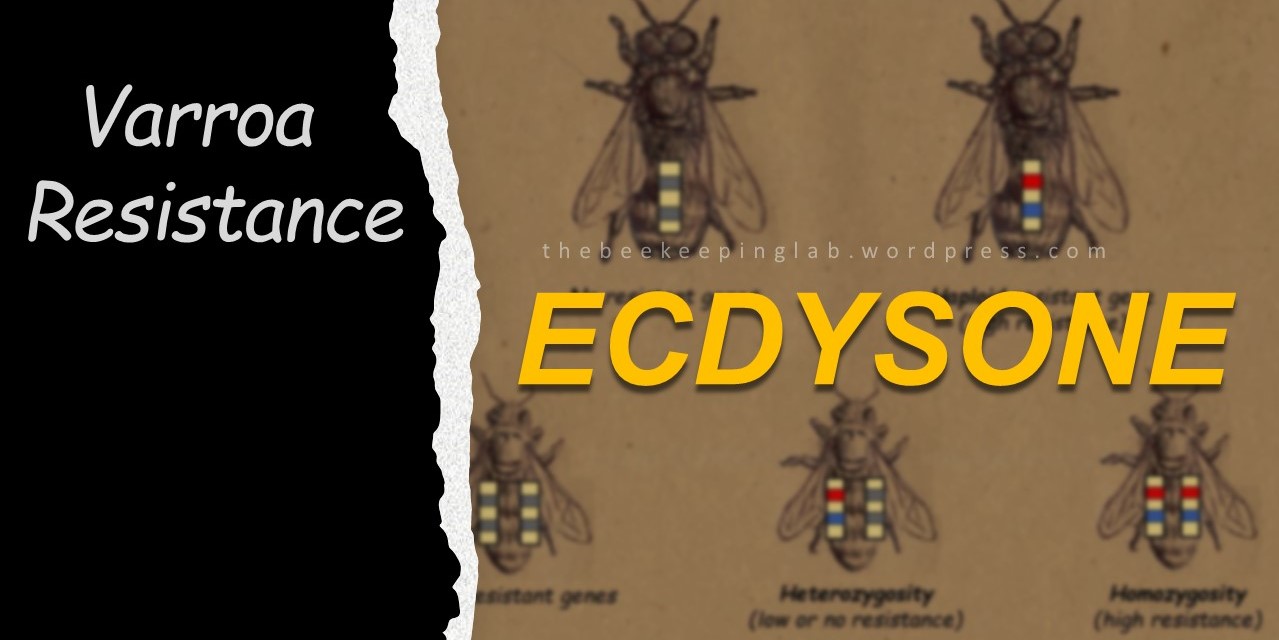Scientists published a paper in 2019 which describes a genetic trait that confers resistance to varroasis in two honey bee populations, one in Toulouse (France) and one on the island of Gotland (Sweden) 1. Both populations, although separated, happen to have the same resistant mechanism. How does this mechanism work? Varroa does not have the ability to synthesize some hormones, so it has to take them from its host. One such necessary hormone is ecdysone. Ecdysone (a steroidal prehormone) is used by the insect in the processes of ecdysis and metamorphosis. A total of three ecdysone related genes were found in these honey bee populations (two genes in the Gotland population and one in the Toulouse population). Disturbances in the intake of ecdysone by varroa mothers can lead them to abort egg-laying. The varroa nymphs which freed on resistant pupae are not able to fully develop, since ecdysone triggers the synthesis of vitellogenin. In both cases, only the varroa mother can emerge after each reproductive cycle alive, which progressively leads to the reduction of the mite population.

In a previous article, the issue of resistance was developed. Some ancestors of these two populations were fortunate to have the few genes that block the reproduction of varroasis. This was a trait caused by one or two gene alleles meaning that it is easily inherited. As a result, its spread under the selective pressure of aggressive parasitism was only a matter of time.
The surprise of the discovery was that while research was directed toward the behavioral resistance traits with sophisticated self-cleaning properties (VSH), eventually a dump biological function emerged 2 . Few could have imagined it. It is impossible not to comment on the opportunistic speculation that sprang up when varroa resistant populations emerged (Gotland, Toulouse, etc.). Without anyone being able to know exactly what has happened, many arbitrary theories have been developed about “how to make bees resistant to varroa”. There was a theorization of the facts (“look how nature gave its own solution“), theorization of the methods (“to accelerate natural selection we follow the X way”). Moreover, this speculation fortified the ambigius doctrines of treatment free beekeeping.

In conclusion, this is an optimistic discovery since it opens up a number of advantages 3:
- The trait is easily inherited, in contrast with the behavioral resistance traits (i.e. VHS, mite-biters).
- It is expressed in the drone, not only in the worker.
- It is preserved over generations, without being particularly affected by the polyandry of the honeybee.
- The identification of resistant bees can be done by rapid laboratory tests instead of complicated and laborious behavioral checks in the field.
It should not be forgotten, however, that such resistance is essentially based on a defective function of ecdysone production mechanism with potential impact on pupae development. We are talking about a slightly defective bee which, however, is not affected by the varroa parasite.
George Mitsikas (Chemist, Amateur Beekeeper)
March 2021 4
It is not allowed to republish the article (re-blogging, etc.), or reproduce it (total / partial) without the permission of the authors.
NOTES – REFERENCES
- A gene for resistance to the Varroa mite (Acari) in honey bee (Apis mellifera) pupae
Mol. Ecol., 28 (2019), pp. 2958-2966 - [3] Update 2023: Such behavioural resistant traits are in fact exaptations, not “natural adaptations” to the parasite. Exaptation is when an old trait of a species is reutilised for another purpose. For instace, grooming behaviour was a trait developed for the acarapis mite and then used for varroa.
- In 2022 Australian scientists announced the development of an anti-varroa drug based on ecdysteroid disruption. https://www.abc.net.au/news/rural/2022-07-25/varroa-mite-pesticide-research/101265928
4. Original article source (Greek):

Leave a comment